Opinionated Audio: David Chesky on Binaural Recording & the Business of Specialized Sound
There is a method to their madness.
For Chesky Records, the how of recording is every bit as important as the who of their roster. This is an audiophile label that was founded not on the premise of spawning smash hits but on providing a distinct listening experience: creating the illusion of live musicians in a 3D space.
David Chesky and his brother Norman started their eponymous label on that path in 1988, their progress since then tracks as an upstart success story. Their artist Paquito D’Rivera’s third Chesky release, Portraits of Cuba, a collection of jazz interpretations of Cuban folksongs, won the 1997 Grammy for Best Latin Jazz Performance.
Along the way, Chesky Records stands as the first company to use 128x Oversampling, and maximized the performance of A/D conversion to help pioneer High Resolution Recordings. They also sport a sister company, HDTracks.com, which allows users to purchase audiophile-grade downloads.
For those who want to listen deeper, Chesky Records launched their Binaural+ series of recordings, which are recorded in 192-kHz/24-bit sound with a Binaural dummy head, to capture the sound of music as you would if you were sitting in front of the band. Proof that the technique works comes in the form of new release like Interplay by the piano/vibes superduo Mark Sherman & Kenny Barron, and In an Ambient Way by Powerhouse (featuring the recently departed saxophonist Bob Belden).
There’s a new release from David Chesky himself, Jazz in the New Harmonic – Primal Scream. It’s an addictive and spacious record of extremely cool jazz, packed with the kind of grooves you’ll dig on repeatedly — even if you’re the staunchest of non-jazz heads (SonicScoop readers can purchase the Primal Scream for 50% until July 15th. Use promo code PRIMALSONIC at http://www.hdtracks.com).
As pure as his intentions are, David Chesky is not a man for all audio – nor is he trying to be. This is a person with strong opinions about sound, and the people who capture it for a living.
What, to you, is the pleasure in listening to a properly executed binaural recording? Explain it to someone who may never have experienced it.
Here’s the thing: most young people now are listening on headphones. Binaural is very cool, because this pinna [points to his ears] tells you everything – you don’t need 20 mics. When you record with the binaural mic in a pinna, it records all the location cues properly: height, depth, 20 locations around.
Think of 5.1 as a hula hoop around your head. But binaural is a sphere – it’s bigger bigger bigger. It’s a density. It’s really 3-D.
How do you personally listen to binaural recordings?
I listen in two ways. All Chesky recordings sound good on speakers, and I also listen on headphones. Right now everyone with headphones or even earbuds will really be in the space.
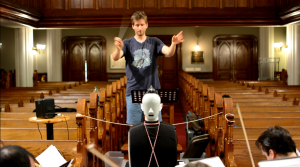
The B&K 4100 Sound Quality Head & Torso simulator on duty for Chesky Records at the German Lutheran Church of St. Paul in Manhattan.
What binaural microphone do you use? Did you audition different ones – how did you arrive at the one you selected?
We use the B&K 4100 head and torso simulator. It’s a crash test dummy, basically. They use this primarily to test factory floor noise levels, it’s so precise. It’s a scientific instrument, but we said, “Let’s use it for recording.” And we did.
Neumann makes a binaural head as well. We tested a few different options. The B&K is a really nice matched system – you can shoot a shotgun off next to this thing and it won’t distort.
In what way is the recording, mixing and mastering process to you THE expression, as much as the song?
We’re minimalists. We have this B&K microphone, with a little silver cable that goes into the mic pre-amps, which goes into the A/D converter at 192 kHz, and from there into the Sonic Solutions DAW. That’s it.
Nicholas Prout is our recording/mastering engineer, and he does editing if we make a mistake. There’s no EQ, no compression. It’s pure. Total dynamic range. It’s the opposite of what pop people do: they squash it.
Why is important to you to hear a “pure” recording?
Here’s the thing: I started out as a studio musician. I was in studios all day long as a conductor. I used to record an orchestra, there were 50 mics all over the place, and I thought that was weird – if you put your head into a trumpet [where they were putting a microphone], it will blow your head off. But you don’t hear instruments like that. You hear them from a distance.
When we started this label, it was from the best seat in the house: the listener position. We started with the AKG 24, doing Blumlein recording. Then we did the Soundfield process, and now are doing binaural. All three of these are from one point, and that’s how it happens so you really get true imaging and correct phase.
I really believe that after two microphones, things go downhill for an acoustic recording. If you’re doing a rap or metal thing, anything goes.
What do you say to people who may beg to differ with that statement?
Recording is an art. Just like you’ve got Italian restaurants, French restaurants, and you’ve also got fast food restaurants.
Our thing is recording real musicians in a real space. That being said, the best way do that is with two microphones and to balance the band, in my opinion. You can do that with a binaural head, or separated mics, and you get real true stereo separation.
But doing a pop record with 48 tracks, that’s a different thing, because you’re making the music in the board – that’s the creative process. That’s not our thing. We’re an Italian restaurant. We set up the black and white picture, and take the shot. That’s the whole thing.
The Song’s the Thing
Are the compositions made with the recording technique in mind?
First of all, I come from a classical background, and I’m a jazz and acoustic musician. I’m used to writing for jazz recordings and operas. You do it with one mic or a hundred mics, its written the same way.
The recording has nothing to do with how the music is composed. It’s how we want the listener to experience the music. In my case, I want to put you in a beautiful, ambient space and experience it like that. My thing is, if you go into a studio, you should do the best you can to capture it well.
What excites me is the tone. A guy like Sonny Rollins practices his whole life to get the tone. A Stradivarius, it’s the tone. And it’s the tone for the guys who play an old electric guitar, and use old Russian tubes in their amp to get the beautiful sound. With binaural recordings, we can capture the nuances of the sound.
Music is about sound. The more crystalline the sound, the better you’re enveloped. It’s a much more satisfying experience.
We could put a transistor radio on the desk here, playing a Beatles song, and it’s not the same. We can play Dark Side of the Moon off of a record, it’s not the same as playing it in a studio and hearing it in there. It’s about taking the sound to the next level. The music is still the same, but it’s a different experience.
A good analogy is this: you’re sitting at home watching A Space Odyssey on a 13-inch black-and-white TV. When you put it on a 46-inch plasma screen, it’s a different experience. That’s what hi-res audio is kind of about.
Just to play devil’s advocate, why is it easier to find a plasma TV today than a quality audio system for playing these recordings?
I think most people are into visuals, but this is a philosophical question. Look at it like this: in the ‘60’s, everyone wanted a great stereo system. Today they have a personal computer, they tweet, they play video games. A young person is happy with earbuds – they don’t have to listen to a stereo.
I don’t know why. Maybe the pendulum will swing back. People like a great HDTV, and I’m kind of perplexed why they want five-dollar earbuds and say, “Screw it. It’s good enough.” But that’s for the anthropologists to answer.
Achieving Balance Without Faders
We spoke about whether or not a song will be recorded in the binaural format affects its composition. I have the same question for arrangements – does binaural recording have an effect on how different instruments are arranged in a song?
No, not at all. Not when you’re writing. But when we go in there to record, we balance it out.
Our sliders are the physical person. We have a mic here, so we tell the person to move in and move out. That’s the only way we can balance it. We tell a guy that they’re playing too loud or too soft. It’s all organic, just like in the old days of playing a concert.
How do you make those decisions during the recording process?
We tweak it. We come in an inch. Like a conductor, we start to fine tune it. Then the band starts to figure it out – they take a tune or two to lock in, and then they start to get it, because they’re used to being in a booth, with headphones on.
Modern recording is a crutch. People want to overdub things, punch in. We’re doing the tightrope without a net. It makes you really pay attention.
Does it intimidate you to work that way?
Not at all. Were comfortable. Were used to it. I think having a microphone in your face is what’s intimidating.
How did you select the venue for the Chesky binaural recordings?
The venues are the ones that let us use them! (Laughs) It’s hard to find a church in the city without a lot of cars and noise, that will rent it to you. Finding a church to record in is like finding something precious and rare – you find it and you don’t let go.
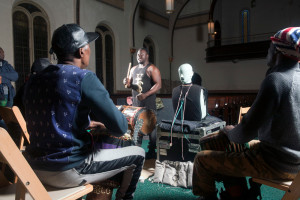
The head on duty at the Hirsch Center in Brooklyn, for an upcoming Chesky release. (Photo credit: Alan Nahigian).
A church like the Hirsch Center, where Primal Scream was recorded, just sounds good. It’s very ambient. You hear these beautiful decays – you can’t get a reverb to sound like a beautiful room. The Hirsch just sounds awesome.
What other churches have you heard in the NYC area?
I’ve heard a lot. St. Paul’s on 60th and Columbus has an eight-second delay. But you don’t want to put a bebop band in there! Some of these spaces you should just landmark them and make them studios.
It sounds like finding the right space is a serious restriction on the binaural recording process.
If you don’t have the right space, go home. You’re done. You think we’ll record it in this office? It ain’t happening.
How many people are on the team for the recordings? What’s special about the setup?
I produce the record, but I’m very involved in the whole thing. Nicholas Prout is our recording engineer and mastering engineer. He kind of runs the show. The second engineer is Milton Ruiz, and the assistant engineer is Max Steen. We also hire interns for the day. The team is basically three people, plus an extra intern.
Here’s the process: If we’re recording on a Tuesday, then we get there on Monday, and do the sound check that day. We let the gear heat up all day, because I don’t like to record with cold gear. I’m really into physically stable stuff — the weird voodoo. We’ll go 11 AM to 11 PM, doing a record per day. We take a break for lunch.
So, say we set up on Monday. Tuesday do a record, Wednesday do a record, Thursday do a record. Once we get the mic set up, we can knock ’em out.
Later on, the artist has to pick the takes. If there’s a mistake we have to edit that, do the tops and tails. There’s still work to be done, but it’s nice to get the recording completed. When you do a multi-track, you don’t spend a whole day in advance setting it up, unless you’re the Rolling Stones. It’s a different thing – an apples-and-oranges type thing.
What have you been learning about listening and recording, as you do more and more binaural projects?
What’s the worst place to hear? Right in front of you! Because of your eyes. It’s hard to auto-locate sound there, but from the side you can hear better – you can auto-locate.
So, for example, instead of putting the head straight up, we tilted it, so we can focus it in. Also soundstage. If you tilt the binaural mic up, you can place the musicians in a different place in the soundstage. If you aim it, you can gently focus it.
But this is a learning process. These are the things we learn when we record. Every time we do it, we feel like we’ve learned something. You’re always on your toes and nervous. It’s flying without a net. All things have to be acoustically balanced for this to work.
Versatile Engineers Wanted
What type of audio engineer is this kind of recording right for?
This is right for capturing acoustical music. But you should learn to do it anyway.
An audio engineer should be versatile. An audio engineer shouldn’t just do Pro Tools – they better be able to capture an orchestra with a microphone. And doing this without EQ and manipulation, hearing how a good signal sounds. Doing it in two microphones, a good mic pre, converter. That’s the reference point. That’s what good sound is.
A lot of people are going into the record business without knowing these things, and it’s getting worse because of the compression and the distortion, and making it for speakers this big (pinches his fingers together), so that if you listen on a big speaker the music is unlistenable. You have to have standards. That’s the way it is.
You have to learn how to do all this different stuff. Listen, when I came to NYC, I wanted to be a heavy metal guy. If you had told me I’d be writing operas, I would have told you that you’re on drugs. The bottom line is the audio engineer today has to have chops. You want to be versatile.
Has it been hard for you to find engineers with the right mindset to work with you?
No, because we find guys on the same team. If you’re not with the plan, you’re not going to be here. People who want to work here are with that plan.
What’s the rig you’ve got on site?
Here we go: The mic in the studio, with the preamps inside of them, running on custom-made silver cables, running into the MSB A/D in the control room, which is the lunch room in the church. The output of the A/D goes into SoundBlade or Sonic Solutions.
That’s our setup. We have a few Macs, and a bunch of hard drives. We run parallel, everything gets recorded by two computers for redundancy – Nick is on his Mac, Max is on his Mac.
We listen to some takes to check it, but we’re not listening to speakers, we’re listening through Ultimate Ears headphones. Once you listen to one or two songs back, you get some confidence, and you go.
Will you play the album straight through?
With my records, we’ll play each tune two or three times. Jazz guys get burned out after a couple of takes. Then Nick becomes the editor – he has enough material to assemble the record.
What’s the single-most important thing to have on hand at these sessions, besides the binaural mic itself?
The most important thing is actually the food! We go to Zabar’s, load up on amazing sandwiches, chips, cakes, and all that. It’s about that. When I walk in, people want to know what’s in the bag.
That’s part of the session – you want to create a nice environment. When a guy is messing up, we say, “You have to do it again, we have a technical problem,” and usually they’ll nail it. We just want to make it really easy, to not make them uptight.
If you’re making music it’s gotta be fun. The sessions are funny, they’re light, we tell a lot of jokes. It’s a lot of pressure to record live, so the band has to be relaxed and totally chill.
I think that’s the best way to make art. I don’t care if you put one million dollar microphone out there, if the musicians are uptight they won’t deliver.
Once everything is recorded, what’s the signal path for mixing and mastering that preserves the purity of your recordings?
There is no signal path, we just export it on the workstation. We clean the tail and the top, put in three or four seconds between each song, and output at 192. But we don’t use EQ, we don’t use compression. Simple. Zen. That’s our theme. A lot of people don’t agree, but that’s the way we do it.
Bringing on the Best Seat
You founded Chesky Records in 1988. Has being a label owner helped you to stay true to your musical roots?
I do two things: I do classical and jazz. Jazz is like playing golf. Orchestra is like working at a factory, with lots of people, lots of rules. Jazz is like relaxing — it’s the opposite of that. It’s just a nice vibe to be in.
Classical is very precision, but jazz is about discovery. You never know what you’ll be playing the next note, which is kind of cool.
On another angle, soon we’ll be coming out with an album called “You’re Surrounded.” Its 360° sound, with instruments in the back of your head, just to prove we can do it.

Is the Chesky style a reaction to the way many other records are produced? Why is it important for you to make records with this “Chesky sound” available?
It’s not a reaction. It’s just what we do. It started with me standing on a podium, conducting an orchestra saying, “Hey man, this is the best seat in the house!”
Why not do something from the perspective of the listener? It’s our trip. It’s our thing. It’s our flavor. Other people have their own flavor.
There’s a lot of discussion about whether or not “quality matters” when it comes to the music business. From a business standpoint, what do you have to say about that – what does the performance of Chesky Recordings Binaural + Series and HD Tracks tell you about that?
Let me tell you something: We make Ferraris. That’s all we know, is quality. We’re not making fast food. My thing is quality. We have the best musicians, the best equipment. The Zen thing is about sound.
We can’t do fast food because I don’t know how to do it. That’s not my thing. If you said, “Go make a rap record,” I wouldn’t know where to start. That’s just the difference.
It seems like consumer education is very important. Do people need to experience better recordings, with the right playback, before they’ll understand the need for higher fidelity recordings?
Yes, you have to experience it. You have to go to a good stereo and hear it. I can tell you all I want, but you have to experience it.
When people go into an electronics store and see the big 4K TV, they say, “That’s cool.” It’s like the 13-inch black-and-white TV thing. It’s the same music, but a different experience.
— David Weiss
Please note: When you buy products through links on this page, we may earn an affiliate commission.







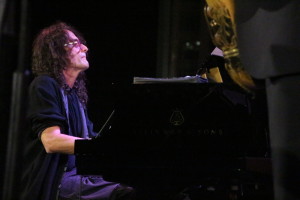
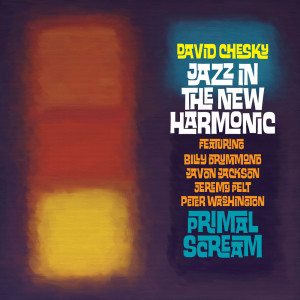
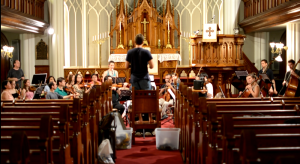
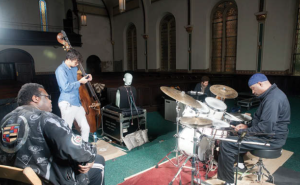
menteur
July 2, 2016 at 2:31 pm (9 years ago)menteur.bandcamp.com
all our recordings are binaural. all of our albums are free.
we love you.